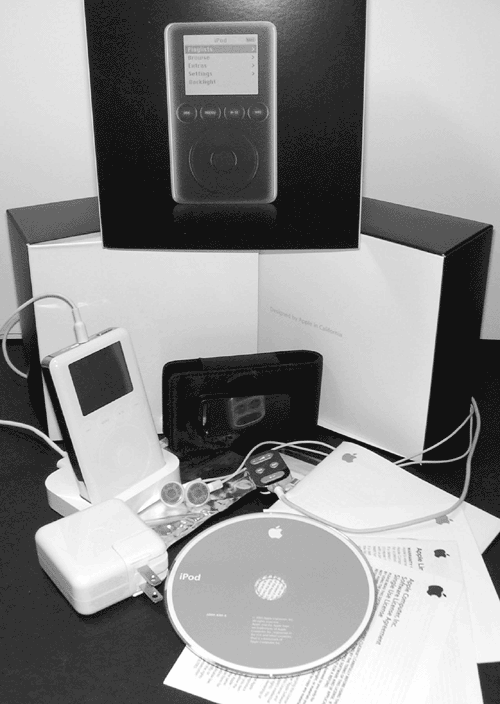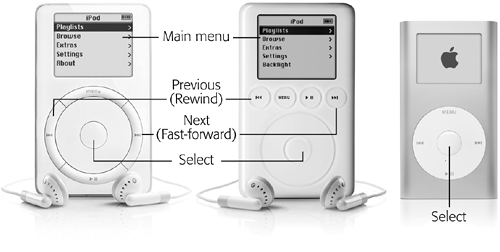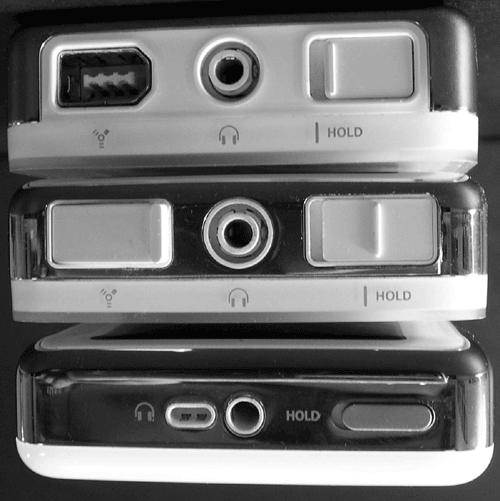1.1 Parts of the Pod
| < Day Day Up > |
1.1 Parts of the PodIn addition to the nicely nestled iPod itself (Figure 1-1), the package's compartments hold all the other stuff that comes with various iPod models: earbud-style headphones and their foam covers, the connection cable for your computer, power adapter, dock, carrying case with belt clip, remote control, and software CD. All you get by way of instructions, though, is a small square folder, including the short iPod User's Guide. Good thing you have the book in your hands to fill in the gaps. Figure 1-1. After the outer sleeve (top) is removed, the artfully designed packaging opens up to reveal the inner iPod. (Don't be deceived by the black-looking iPod photo. That's supposed to show what the thing looks like in the dark. There's no such thing as a black iPod ”at least not yet, although a company called Colorware will sell you a hand- painted Pod at http://www.colorwarepc.com. (And you can always indulge your color whims with an iPod Mini.) The iPod comes with all the hardware and software you need to get up and running, but the choice of music to put on it is up to you. If your iPod model didn't come with all the accessories shown, you can probably find most of them for sale on the Web. You'll probably blow right past the warranty information (basically, you're covered for one year) and the software agreement (the usual legalese that makes most people's eyes glaze over like fresh Krispy Kreme doughnuts). The software agreement includes a small section about making digital copies of music, whose sentiment is echoed right on the iPod's cellophane wrapping: Don't steal music. 1.1.1 The ScreenThe monochrome LCD screen is your window into the iPod's world. You can use it to navigate the menus , see how much of a charge the battery has left, and view the name of the current playlist or song. The display, whose resolution is 160 x 128 pixels, also comes with a white backlight, so you can still use your iPod in movies, concerts, and coal mines. NOTE The iPod screen uses the Chicago font, which should be familiar to Macintosh veterans .
1.1.2 The Scroll WheelThe concentric ring on the iPod's face is the scroll wheel, which you use to navigate up or down lists of menu options on the screen. It lets you jump to a specific playlist, album, artist, song, or even a certain part of a song. When a song is playing, you can also use the scroll wheel to adjust the iPod's volume: Spin the wheel counterclockwise to turn the volume down, or clockwise to increase the sound. Of course, "spin" may not quite be the right word. The wheel on the 2001 iPods actually turned. But on the 2002-and-later iPods, including the iPod Mini, the turning wheel gave way to a stationary touchwheel, which you operate by dragging your finger around the ring. You've got one less moving part to go bad. NOTE Want to personalize your Pod forever? Say it with lasers ”laser engraving , that is. You can immortalize the chrome backside of your iPod with a short, two-line message of your choosing for an extra $19 when you order an iPod at http://store.apple.com. Just don't make a typo. 1.1.3 The Buttons The first generations of iPod had raised, contoured control buttons ”Menu, Beginning with the 2003 iPods, Apple made all the buttons nonmoving, touch-sensitive parts (Figure 1-2). This design offers two advantages: It keeps sand and dirt from derailing the iPod's parts, and it lets a red-orange glow backlight the names of the buttons when it's dark out. Many iPodders complained, though, that the new layout makes it more of a thumb reach to hit the Figure 1-2. Pressing any button turns on the iPod. The original iPod design (left) had the control buttons around the scroll wheel. On later iPods (middle), the control buttons are above the scroll wheel. The iPod Mini (right) puts the controls on a springy "click wheel" that combines the tactile response of the original iPods with the smooth surface of the wheel. Owners of the iPod Mini don't have to worry about that; its buttons are actual, clickable spots on the 12, 3, 6, and 9 o'clock positions on the scroll wheel. If you're old enough to own an iPod, your thumb can probably reach them. In any case, no matter which model you have, no matter where the control buttons have migrated , they all work the same way once you find them. Starting from the center, here are the controls:
NOTE These buttons, used in combination, also let you reset a locked-up iPod. Details in Chapter 15. 1.1.4 Places for PlugsHere are the various switches and connectors you'll find on the top and bottom of your iPod, as shown in Figure 1-3:
Figure 1-3. The headphone jack in the center and the Hold switch on the right side have remained up top in all generations of the iPod, but the FireWire port has roamed. The original 2001 iPod (top) is wider than later models and has no plastic cover for the FireWire port like the 2002 iPod (middle) does. The 2003 iPod (bottom) and the iPod Mini (not shown) has a remote jack closely aligned with the headphone port in the center. The Hold switch is still off to the right, but the FireWire port has changed shape and migrated to the bottom of the device. NOTE A common moment of iPod panic occurs when the device's control buttons don't seem to be working. Check the top to make sure the Hold switch isn't on. If your iPod model includes a remote control, check the Hold button on the remote as well. |
| < Day Day Up > |
EAN: 2147483647
Pages: 171